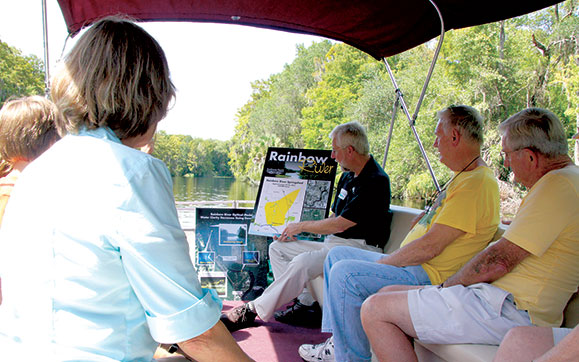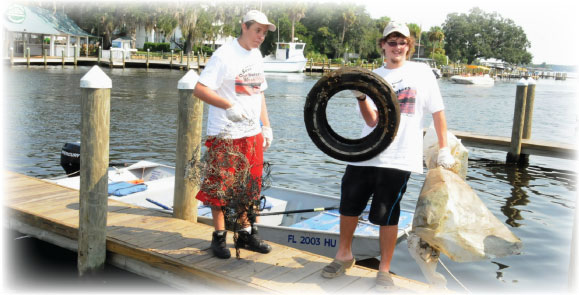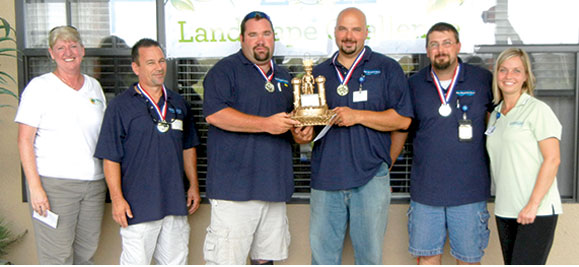Joint Effort Educates Residents on Protecting Vital Resource
Volunteers retrieve debris from Kings Bay during Citrus County’s Save Our Waters Week.
The District’s 2011 observance of Springs Awareness Week helped more residents understand their effects on the health of springs, thanks to a joint venture with two northern counties.
The District joined Citrus and Marion counties to mark Springs Awareness Week Sept. 16–24. The week combined Citrus County’s Save Our Waters Week and Marion County’s Springs Festival to provide springs protection information to more than 2,000 residents. Events included lake and shoreline cleanups, guided hikes, boat tours, water education workshops, festivals and a springshed tour.
“We helped people understand that everyone has an impact on the health of our springs, even in their own homes,” said Virginia Sternberger, District senior communications coordinator. “Springs protection starts in our own yards, especially for those who use lawn fertilizer.”
District staff led the Springs Neighborhood Challenge event, which educated residents about rising nitrate levels in springs due to the overuse of lawn fertilizer, among other issues. The event included presentations by springs experts, hands-on activities about watershed protection, boat rides on the Withlacoochee and Rainbow rivers and a game modeled after the television game show Jeopardy that tested participants’ knowledge about local springs.
The District also helped organize the Landscape Challenge competition. Four teams of landscape industry professionals competed in a circuit of challenges testing their knowledge and skills about landscaping and fertilizing practices that help protect water quality in springs.
District Takes Home “Ruling Water Champion” Award
Left to right, Merry Mott from the Florida Nursery, Growers and Landscape Association; District Tradesworkers Roger Rutter, Kris Miller and Jeff Toth; District Senior Tradesworker Silas Rooker; and District Senior Communications Coordinator Virginia Sternberger celebrate the District’s win of the 2011 Springs Awareness Week Landscape Challenge. Teams competed against each other by demonstrating landscape management practices that will help protect water quality in springs. The competition was sponsored by the District and coordinated by the Florida Nursery, Growers and Landscape Association.
About Florida’s Springs
With more than 700 springs in the state, Florida has the largest concentration of springs in the world. Within the District, there are an estimated 150 springs that form the headwaters of several major rivers.
A spring is a natural opening in the ground where water flows directly from the aquifer to the earth’s surface. The source of this fresh water is from seasonal rainfall that soaks into the ground, which is referred to as groundwater. Springs form when groundwater is under pressure and flows up through an opening called a spring vent, supplying flow to a river or other water body. A spring can occur individually or as a group of many springs.
Springs in the District are supplied from groundwater in the Upper Floridan aquifer—the same aquifer that provides the majority of the region’s drinking water. Over time, spring water quality has been threatened by impacts associated with growth and poor irrigation and fertilization practices. Therefore, it is important to learn what we can do to help protect and restore these natural treasures.

Dr. Bob Knight from the Howard T. Odum Florida Springs Institute guides a tour on the Rainbow River during Marion County’s Springs Festival.
The water quality of springs can be harmed by a variety of actions, including improper fertilization techniques, infrequent septic tank maintenance, improper disposal of garbage, and stormwater runoff.
Fertilizer: Too much fertilizer applied to landscapes seeps past the root zone of the grass, plants or trees and into the aquifer or runs off into streams, lakes or bays.
Septic Systems: Septic tanks that are not properly maintained can pollute the groundwater that ultimately emerges from springs. Septic tanks are often forgotten until there is a problem. However, long before the problem is discovered, area waters may already have been negatively affected.
Sinkholes: Many times sinkholes are directly connected to the aquifer. As a result, debris found in them can have a significant impact on the quality of the water leaving the spring.
Stormwater Runoff: Stormwater ponds, if properly maintained, can help prevent flooding and filter out pollutants before they reach water bodies. You can help improve the quality of water that enters stormwater ponds and promote a healthy environment within your community by cleaning up litter, spilled fertilizer, grass clippings, motor oil and pet waste before these materials enter storm drains and flow into water bodies. It’s also important to avoid cutting your lawn too short, which reduces its ability to capture and filter water before it enters a pond.
For more information about springs, visit WaterMatters.org/springs or order your free copy of the District’s “Understanding and Protecting Your Springs” brochure.


